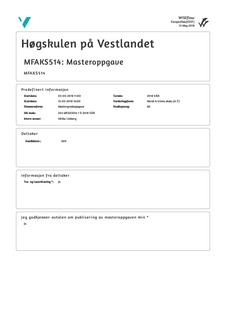| dc.contributor.advisor | Aadland, Eli Kristin | |
| dc.contributor.advisor | Wergedahl, Hege | |
| dc.contributor.author | Balm, Maaike | |
| dc.coverage.spatial | Norge | nb_NO |
| dc.date.accessioned | 2018-06-26T08:25:06Z | |
| dc.date.available | 2018-06-26T08:25:06Z | |
| dc.date.issued | 2018-05-15 | |
| dc.identifier.uri | http://hdl.handle.net/11250/2502945 | |
| dc.description | Masteroppgave i fysisk aktivitet og kosthold i et skolemiljø | nb_NO |
| dc.description.abstract | Hensikt og problemstillinger: Elever møter på skolen med ulike forutsetninger. De vil ha
ulike læringsstiler og intelligenser. Ulik grad av selvdisiplin, motivasjon, opplevelse av
mestring, samt trivsel i fagene og skolehverdagen generelt. Dette gjør det interessant å
undersøke elevers atferd i klasserommet og eventuelle kontraster i et fag preget av mye
praktisk og skapende arbeid, sammenlignet med et fag preget av mye teoretisk arbeid. Studien
vil undersøke likheter og forskjeller i atferden til elever som strever og elever som fungerer
godt i fagene mat og helse og matematikk. Undervisningens praktisering i fagene, samt
klassens atferd vil også trekkes frem.
Materiale og metode: Studien benytter det kvantitative datamaterialet samlet inn skoleåret
2007-2008, i forbindelse med prosjektet Kvalitet i opplæringen (KIO), initiert av Høgskulen i
Volda. Observasjonene i datamaterialet ble samlet inn ved bruk av metoden "momentary time
sampling". Utvalget består av observasjoner fra 21 klasser i mat og helse og 25 klasser i
matematikk og totalt 119 ID-numre fordelt på 65 forskjellige elever på 6.- og 9. trinn. 65 av
ID-numrene tilhørte gutter og 54 tilhørte jenter.
Resultater: Elevene som strevde hadde mindre selvdisiplinert atferd enn elevene som
fungerte godt. De behøvde mer lærerstøtte, forstyrret og var mer uvirksomme, mens elevene
som fungerte godt lyttet, samhandlet og arbeidet mer. I mat og helse samhandlet begge
elevkategoriene i større grad, mens de i matematikk lytter mer til læreren. Blant elevene som
strevde ble det arbeidet mer med arbeidsoppgaver i mat og helse enn i matematikk.
Timesignaturene viste også en tidligere økning i den mindre selvdisiplinerte atferden i
matematikk. Undervisningen i mat og helse bar mye preg av gruppearbeid, felles
arbeidsoppgaver og bevegelse, mens det i matematikk var mye helklasseundervisning,
individuelt arbeid, arbeidet med felles arbeidsoppgaver, arbeidsplaner, samt at klassen lyttet
mer og lengre til lærer enn i mat og helse.
Konklusjon: Det var tydelige forskjeller i atferden til elevene som strevde og elevene som
fungerte godt i begge fag. Resultatene viste noen mindre tendenser til ulik atferd mellom de to
elevkategoriene da mat og helse og matematikk ble sammenlignet. Det var også kontraster i
undervisningsform, arbeidsform og klassens atferd i de to fagene | nb_NO |
| dc.description.abstract | Purpose and problem: Students show up to school with varying prerequisites. They have
different learnings styles and intelligences, varying ability to be self-disciplined, motivated,
experience wellbeing and master the subject and school life in general. The students’
classroom behaviour will therefore be interesting to examine. Are there variations in their
behaviour in a subject with a lot of practical work compared to a subject with a lot of
theoretical work? The study will examine behavioural similarities and differences between
students who struggle and students who perform well in school in the subjects Food & Health
and Mathematics, as well as the education practises and the behaviour of the class.
Method and selection: This study consist of quantitative data, collected in the project
Kvalitet i opplæringen (KIO) / Quality in education, by Høgskulen i Volda in the school term
2007-2008. The observations were gathered by using the method momentary time sampling.
The selection consists of observations in 21 different Food & Health classes and 25 different
Mathematics classes and in total 119 ID numbers distributed on 65 different students from 6th
and 9th grade (Norway). 65 of the ID numbers belong to boys and 54 belong to girls.
Results: The students who struggled showed less self-disciplined behaviour than the students
that performed well. They needed more teacher support, interrupted and were idle while the
students who performed well listened, interacted and worked more. The students interacted
more with each other in Food & Health, while they listened more to the teacher in
Mathematics. The students who struggled worked more on tasks in Food & Health and the
lesson signature showed an earlier increase in the less self-disciplined behaviour during the
Mathematics class. In the Food & Health class there were a lot of group tuition, common
tasks and movement, while it in Mathematics were a lot of class and individual tuition,
common tasks and work plans and they also listened more and longer to the teacher.
Conclusion: There were in general clear differences in the behaviour of the students that
struggled and the students that performed well. The results showed some smaller differences
in the different kinds of behaviour of the students who struggled and the students who
performed well, compared in the two subjects Food & Health and Mathematics. There also
were some differences between the two subjects, regarding type of education and work and
the behaviour of the whole class. | nb_NO |
| dc.language.iso | nob | nb_NO |
| dc.publisher | Høgskulen på Vestlandet/ Western Norway University of Applied Sciences | nb_NO |
| dc.rights | Navngivelse 4.0 Internasjonal | * |
| dc.rights.uri | https://creativecommons.org/licenses/by/4.0/deed.no | * |
| dc.subject | Læringsatferd | nb_NO |
| dc.subject | Mat og helse | nb_NO |
| dc.subject | Matematikk | nb_NO |
| dc.subject | Learning behaviour | nb_NO |
| dc.subject | Food & health | nb_NO |
| dc.subject | Mathematics | nb_NO |
| dc.title | Elevers læringsatferd i mat og helse og matematikk | nb_NO |
| dc.title.alternative | Students’ learning behaviour in Food & Health and Mathematics | nb_NO |
| dc.type | Master thesis | nb_NO |
| dc.description.version | publishedVersion | nb_NO |
| dc.rights.holder | Maaike Balm | nb_NO |
| dc.description.localcode | MA-FYSAK | nb_NO |

